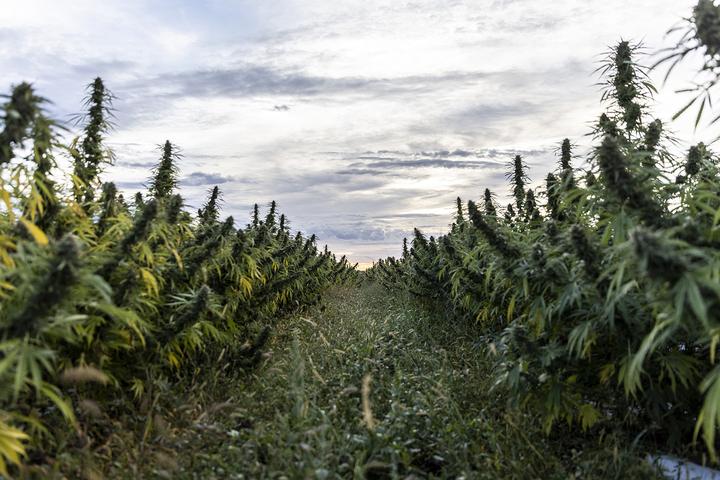
What Are Minor Cannabinoids? A Full Guide
3/12/2024
Innovation & Production
Contents
Understanding Cannabinoids
The World of Minor Cannabinoids
Minor Cannabinoids in Consumer Products
The Future of Minor Cannabinoids
Conclusion
Frequently Asked Questions
Understanding the makeup of cannabis sativa plants is crucial to appreciating the benefits of each strain. There are over 100 cannabinoids identified, they each work together to deliver the effects attributed to each strain.
How do they impact the highly sought after medicinal and therapeutic benefits of cannabis?
Major cannabinoids refer to those found in abundance and often play a larger role in the overall effects. Minor cannabinoids, on the other hand, are less abundant, but still have an impact on the effects experienced.
Let’s learn more about the minor cannabinoids and their benefits.

Understanding Cannabinoids
The term cannabinoids refers to a chemical compound that interacts with the cannabinoid receptors in the body. These cannabinoid receptors are also found in the brain, producing the effects expected from cannabis plants and their extracts.
The cannabinoid makeup differs between strains and even plants. Each cannabinoid reacts to the endocannabinoids within the body. This reaction creates feelings of relaxation and euphoria.
When we talk about major cannabinoids, we’re referring to tetrahydrocannabinol (THC), cannabidiol (CBD), and cannabigerol (CBG). CBD and CBG are known to help ease conditions like pain, anxiety, depression, and inflammation.
THC is a psychoactive compound that delivers mind-altering effects. All of these compounds are commonly found in products like tinctures, oils, and edibles, and topical creams.
Cannabinoids interact with terpenes to deliver the effects of the cannabis strains. This is referred to as the entourage effect and intensifies the experience when cannabis is consumed.
The World of Minor Cannabinoids
While there are over 100 cannabinoids identified, more are discovered each year. Minor cannabinoids refer to any other than THC and CBD. Many of them are known for their medical application.
Some noteworthy minor cannabinoids include:
Cannabigerol (CBG)
Cannabigerol (CBG) is one of the compounds resulting from decarboxylating cannabigerolic acid (CBG-a). It’s one of the most significant of the minor cannabinoids, with the highest quantities found in young cannabis plants.
Over time, CBG levels break down throughout the plant’s life cycle. It’s been dubbed the “mother cannabinoid” since all cannabinoids are derived from CBG-a.
Research into the medical benefits is relatively new, but so far, we know it’s just as powerful as CBD. Its potential benefits include combating mental and physical health concerns like:
- Anxiety relief: CBG has shown to increase the serotonin levels in the brain, making it a natural treatment for depression and anxiety.
- Antibacterial properties: CBG has shown promise in helping to fight antibiotic resistant infections.
- Pain relief: The anti-inflammatory and relaxing properties of CBG make it a promising natural treatment for pain.
- Muscle relaxant: Promising results indicate the potential to treat sports injuries, muscle strain, and bladder disorders.
- Anti-inflammatory properties: Testing has revealed that CBG could treat inflammatory conditions like Inflammatory Bowel Syndrome (IBS).
- Glaucoma relief: Like other cannabinoids, CBG could help relieve intraocular pressure caused by glaucoma.
- Cancer treatment: As with other cannabinoids, it may stimulate the appetite and suppress nausea and vomiting in patients undergoing chemotherapy.
Cannabinol (CBN)
A mildly psychoactive cannabinoid, cannabinol (CBN) is commonly found in matured buds. It’s derived from THC, the plant’s psychoactive chemical.
It’s worth noting, though, that CBN levels are lower in cured buds. The compound is well known as a sleep aid. Other medicinal benefits include:
- Anti-inflammatory
- Appetite stimulator
- Neuroprotectant
- Antibacterial
Cannabichromene (CBC)
Cannabichromene (CBC) is a phytocannabinoid that has the structural similarity to other natural cannabinoids. Research has shown that, on its own, CBN doesn’t have many benefits.
When working in tandem with other cannabinoids, as part of the entourage effect, however, CBN is believed to help treat:
- Inhibits acne
- Pain relief or prevention
- Antidepressant
- Anti-inflammatory
Tetrahydrocannabivarin (THCV)
Commonly found in strains from central Asia and South Africa, Tetrahydrocannabivarin (THCV) lessens the psychoactive effects of THC. While most strains have trace amounts of THCV, it is most abundant in sativa strains.
Some potential benefits include:
- Suppresses appetite
- Stimulates bone growth
- Increases satiety
- Reduces panic attacks
- Helps to promote weight loss
Cannabidivarin (CBDV)
Cannabidivarin (CBDV) is a non-psychoactive cannabinoid that modulates the physiological activity of cannabis. It’s mainly found in indica strains originating in Africa and Asia.
The compound is also found in strains with lower THC as it commonly accompanies CBD.
Potential therapeutic benefits include:
- Antiepileptic
- Reduces seizures
Cannabigerovarin (CBGV)
Found on a small group of cannabis phenotypes, cannabigerovarin (CBGV) is the result of natural mutation or laboratory intervention. Very little is known about the compound, leaving no room for definitive determinations about its potential benefits.
Minor Cannabinoids in Consumer Products
With over 100 identified cannabinoids, continued research is going into gaining more information about their health and wellness benefits. Embracing the entourage effect, many products are hitting the shelves with the predominant THC or CBD properties.
From skincare topicals to energy boosting gummies, cannabinoid-infused products are growing more popular.
Where do you find quality extracts to use in your infused products?
Get in touch with Materia Regenerative for high quality, organic, hemp-derived ingredients. We also create custom products from USDA organic ingredients.
At Materia, our goal is to help your brand grow with each unique product and service.

The Future of Minor Cannabinoids
As hemp and cannabis have grown in popularity, so have their extracts. Not only have the major cannabinoids gained traction, so have the minor cannabinoids.
With more research being done on cannabinoids, we have a greater understanding of the potential medical applications. The great news is that, as more cannabinoids are identified, the list of possible wellness and therapeutic benefits grows too.
With more recognition going to these impressive compounds, they also have a more exciting investment potential. Estimations put the global cannabinoid market value at USD 45 billion in 2024. Projections for the US CBD market have it reaching USD 13.4 billion by 2028.
The FDA approval of Epidiolex was the catalyst for further trials around minor cannabinoids. It’s believed to have significant pain relieving properties and may help against the side effects of cancer treatments. These possibilities, however, are still only theories and need further research.
As more evidence becomes available, the minor cannabinoids have the potential to play a larger role in wellness than we anticipate.
Conclusion
Minor cannabinoids are often overshadowed by the more prominent THC and CBD. They’re gaining recognition for their significant therapeutic potential and diverse benefits. With each compound exhibiting distinct properties and potential benefits, it’s clear to see why they’re growing in popularity.
From anti-inflammatory and neuroprotective properties to skin care and sedative qualities, minor cannabinoids unlock a wealth of possibilities.
As research advances, we could see minor cannabinoids being used in targeted treatments for a wide range of medical conditions. These advancements offer alternative and personalized options for managing their health and well-being.
Reach out to Materia Regenerative today for quality organic concentrates and personalized products.
Frequently Asked Questions
Do minor cannabinoids have any potential therapeutic benefits?
They absolutely do! While research is still ongoing, the findings to date suggest that minor cannabinoids could have some benefits. It’s believed to have analgesic, anti-inflammatory, and anti-anxiety possibilities.
Can minor cannabinoids be used for pain management?
Yes, some minor cannabinoids, like CBN, present analgesic properties, making it a potential pain management method. It’s crucial to note, though, that research is still ongoing to determine its efficacy.
How do minor cannabinoids interact with the endocannabinoid system?
Minor cannabinoids bind to the cannabinoid receptors (CB1 and CB2) in the endocannabinoid system. They modulate various physiological processes like appetite, mood, and immune function.
How are cannabinoids extracted
The extraction process has various methods, but the most popular involve CO2 or solvent-based methods.
What are the potential side effects of minor cannabinoids?
Whether major or minor cannabinoids, the possible side effects remain the same. They’re generally considered safe, but can present effects like drowsiness, change in appetite, or dry mouth.
Can minor cannabinoids be used in skincare products?
Yes, they can. Minor cannabinoids are being used in more skincare products because of their anti-inflammatory and antioxidant properties. These products are believed to help improve various skin conditions.
What is the entourage effect?
The entourage effect refers to how cannabinoids and other compounds work together to intensify their properties.
How do minor cannabinoids differ from synthetic ones?
Minor cannabinoids occur naturally within the cannabis plant. Synthetic cannabinoids are created in laboratories. These artificial cannabinoids do not have the same safety and efficacy as their natural counterparts.




